This essay was co-authored by Andrew Kortina and Namrata Patel.
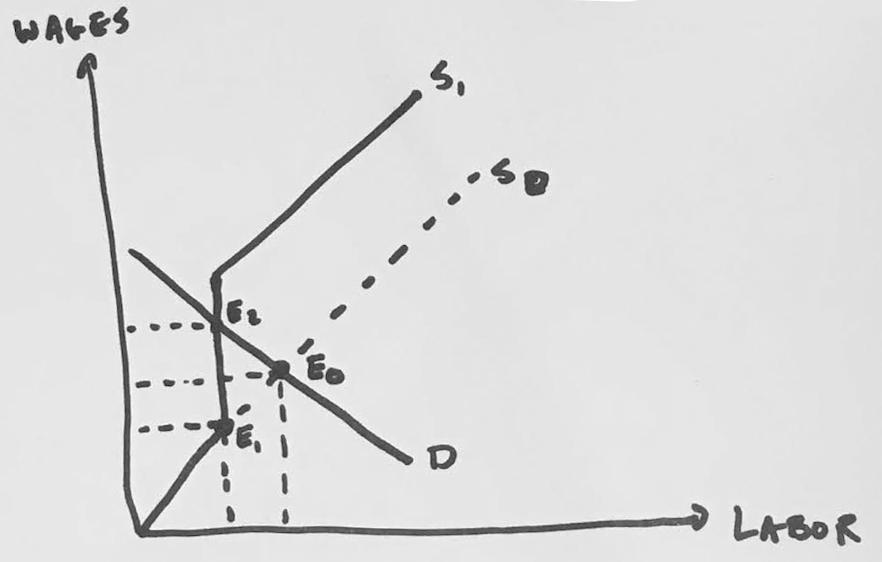
Over the past few decades, labor force participation has sharply dropped for men ages 20-34. Theories about the root cause range from indolence, to a lack of skills and training, to offshoring, to (perhaps most interestingly) the increasing attractiveness and availability of leisure and media entertainment. In this essay, we propose that the drop in labor participation rate of young men is a result of a combination of factors: (i) a decrease in cost of access to media entertainment leisure, (ii) increases in both the availability and (iii) quality media entertainment leisure, and (iv) a decrease in the marginal signalling utility of (conspicuous) consumption goods for all but the highest earners.
At the macro level, this results in sub-optimal production, as firms are unable to satisfy their demand for labor via the usual mechanism of increasing wages. If you believe that economic productivity and growth are good, this presents a challenge when attempting to design stimulus policy, because subsidies or increases to the minimum wage would yield the same non-result as firms increasing wages. We discuss the potential efficacy of the somewhat radical idea of a tax on human attention or time spent consuming entertainment media as a way to stimulate productivity.
Declining Labor Participation in Younger Demographics
The overall labor force participation rate in the United States has been declining for the past several decades. The most obvious potential explanation would be an aging population (retirees comprising an increasing percentage of the overall population), but you can see this is not the root cause when you break out the labor force participation rate by age and sex:
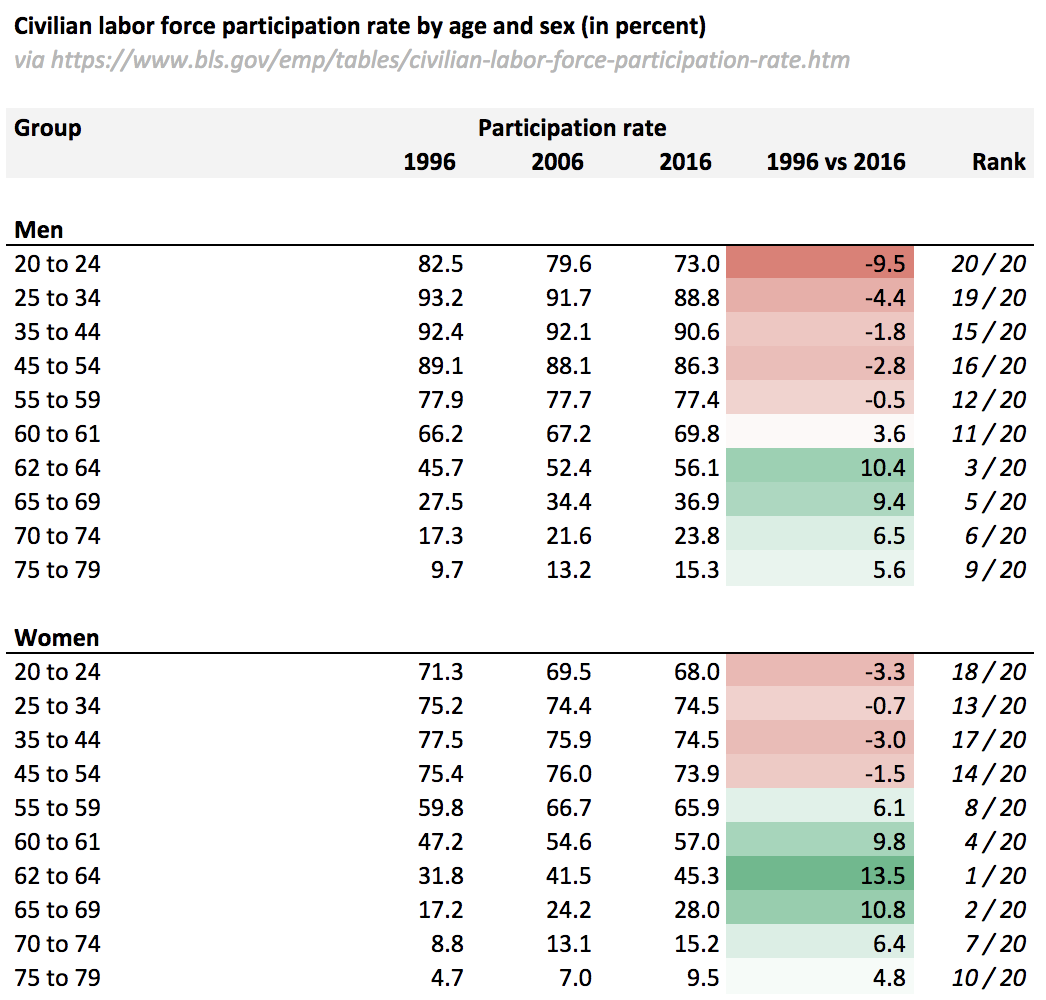
Labor participation has been dropping much faster for young men than any other groups. (Interestingly, labor participation has been increasing most rapidly for older demographics, presumably because they must continue working later in life in order to support basic needs and healthcare costs).
In Leisure Luxuries and the Labor Supply of Young Men, Mark Aguiar and Erik Hurst note that:
Despite stagnant wages, declining employment rates, and an increased propensity to live with their parents, younger men report increased happiness during the 2000s. This contrasts sharply with older men, whose satisfaction fell along with their relative earnings. We see the life satisfaction results as indirect evidence that younger men experienced relatively little decline in the consumption and greatly valued their improved leisure options.
Much of young men’s time which in past decades was spent working is now spent playing video games, according to Aguiar and Hurst. Given that reported happiness moved in the opposite direction from wages and employment rate, it would seem there is some preference for this specific type of leisure over the purchasing power sacrificed in the form of foregone wages. But given that leisure activities have always been an alternative to work, we should ask what about video games specifically makes them more compelling than historical leisure activities.
Decreasing Cost, Increasing Availability, and Increasing Quality of Media Entertainment
Video games are just one example of media entertainment content that has become more a more attractive leisure choice as a result of advances in internet and mobile device technology.
For most of history, media consumption was bounded, like other forms of consumption, by cost – if you wanted more books, movies, music, console video games, etc, you needed money to buy them. Notable exceptions to this pattern were radio and cable television, where you could access programming at all hours of the day for a low fixed cost (or in some cases for free) – but in these cases, limits on the syndication of premium content entailed that not every hour of watching was equally enjoyable, and there were generally still diminishing (enjoyment) returns on each additional hour spent watching.
The digitization of content enabled infinite storage of evergreen content in the cloud and effectively zero marginal distribution cost of content through copying. Enabling on-demand access to all of the content that has ever been produced entailed a huge increase in the supply of good content. This essentially made all of history a viable competitor to people producing new content. Similarly, social media–produced for free, by amateurs–provided another huge influx of new content and more competition for attention.
This increased supply and competition put pressure on professionals creating new content to make it better and cheaper. On top of that, taking a page from the cable TV playbook, internet media distributors gave away content for free, and used advertising subsidies to pay for the small amount of content that was still being professionally produced.
All of these changes benefited the consumer by making more and better content available for free. Today, you can pretty much always spend yet another hour consuming some new and interesting content freely available on the internet, so once you have paid the (quite cheap) cost of access to your ISP or mobile data provider, you no longer require additional wages to pay for additional consumption of media as a leisure activity.
Decreasing Signalling Utility of Conspicuous Consumption Goods
Before we accept that young men are simply foregoing working in favor of spending more time playing video games or consuming other forms of media entertainment content, we should ask what else they might spend foregone earnings on and why they are not working to fund that spend.
In general there are three types of goods: goods that meet your basic needs, leisure goods (including media goods), and conspicuous consumption goods (those that signal genetic fitness, social status, belonging, etc.). If young men playing video games are not foregoing their basic needs (an assumption we’ll make here), and the cost of media entertainment goods has dramatically fallen, then they must be trading off consumption goods. Next, we argue that this group has decreased consumption because the signaling utility of these goods has decreased.
What is conspicuous consumption and what does it take to get it?
Historically, the primary purpose of working was to generate enough income to satisfy basic needs. Once those needs were met, an individual had a tradeoff to make between spending their remaining time on work or leisure.
Observing the behavior of the nouveau riche in a post-industrialization society in the late 1800s, Thorstein Veblen introduced the theory of conspicuous consumption - the purchase of goods and services for the sake of signalling social status (vs. the intrinsic function provided by goods that meet basic needs or those that enable leisure).
As living standards improved in the 20th century and individuals had more discretionary income, this behavior expanded to men, women, and children across all economic classes who began to spend more money on goods and services as a sort of social fashion. Implicit in spending more time on work is a preference for conspicuous consumption over leisure.
If you have the money, how do you decide what to consume? Benjamin Schwarz suggested in his review of Elizabeth Currid-Halkett’s The Sum of Small Things: A Theory of the Aspirational Class that:
This process depends on the great extent to which the elite’s consumption is at once devoted to and relies on “cultural capital”—that is, the adoption of values, tastes, and norms through social inculcation and formal education. That cup of Intelligentsia coffee may “only” cost five dollars, but learning about it in the first place depends on prizing the judgment of certain cultural tastemakers (again, say, the New York Times and those right-thinking podcasts), and on possessing a worldview that attaches a particular value and virtue to a particular container of hot liquid. Acquiring that cultural capital is, itself, a rarefied and usually expensive endeavor, because it involves a lengthy and complex process of what the sociologists call cultural and social formation: The peculiar cachet that the educated class attaches to that cup of coffee is far more likely to elude the daughter of an insurance adjuster brought up in Lansing, Kansas (a middle-class suburb of Kansas City), who attended the local high school and Kansas State, than it is the daughter of a screenwriter raised in uber-achieving north-of-Montana-Avenue Santa Monica, who attended the Harvard-Westlake School and Yale. Thus, buying that cup of coffee—or that organic cotton t-shirt, or that subscription to Harper’s—signifies a class identity that the purchase, in turn, reinforces.”
The increased cost in time to acquire the knowledge of what to consume is yet another way that conspicuous consumption is becoming prohibitively more expensive.
The catch with all of this is that the psychological utility sought from conspicuous consumption is relative, not absolute. Sarah Perry sums this up nicely in her book, Every Cradle is a Grave:
More than anything, however, a human utility function is a function of social belonging. That’s the ultimate point not only of income, but of intelligence, beauty, and many other material and non-material goods: they may be traded for social belonging… We want income because we want to be able to get the attention of others. We want a safe social place, primarily—and, of course, we want a better social place than the one we currently occupy.
The implication of this relative sizing up is that there is an ever-rising bar to maintain or improve your social position relative to the people and communities from which you seek affiliation or belonging. This was never easy given the money and time required, but at least it was possible when you sought that social belonging from people and communities that were more geographically constrained.
How does scale of distribution impact conspicuous consumption?
Consumers are no longer signaling on a local scale, but rather on an internet scale. On the one hand, this amplifies signal, because you can reach likeminded people who aren’t part of your local community, but on the other hand:
-
The consequent noise of everyone else doing the same thing crowds that signal out.
-
The people you may be trying to reach may be more preoccupied than ever before given the media dynamics described above playing out.
-
Together, these changes increase competition for the attention of the people whose attention you’re vying for…
-
And stoke an arms race in money and time in pursuit of relative conspicuous consumption.
We believe that this effect can be extrapolated into most contexts where digital distribution is used for signalling purposes. Yes, you could work more in order to buy more consumption goods, services, and activities and spend more of your free time posting about it online in order to break through, but it’s a grind given the ever-escalating, relative nature of the competition.
Unless the lottery or a new work opportunity vaults you into the top 20% of income earners or you’re fine spending the majority of your time crafting your online image like the Maya Millenials out there, you have little chance of breaking through. And if there is no meaningful signalling utility from the consumption goods, services, and activities you could buy with increased income, why work more than you need to meet your basic needs and fund leisure? Paul Nystrom dubbed consumerism as a “philosophy of futility,” and with the Internet stoking conspicuous consumption into overdrive, more people may be starting to sense that.
What are the implications of worker preference for leisure over wages?
A common response to a high unemployment rate, low labor force participation, and low economic productivity is the proposal of increasing wages / the minimum wage. This proposal stems from the idea in classical economics that there is a smooth, upward sloping labor supply curve, where each increase in wages yields a corresponding increase in labor supply (because the higher wages entice more people to work or people to work more hours):
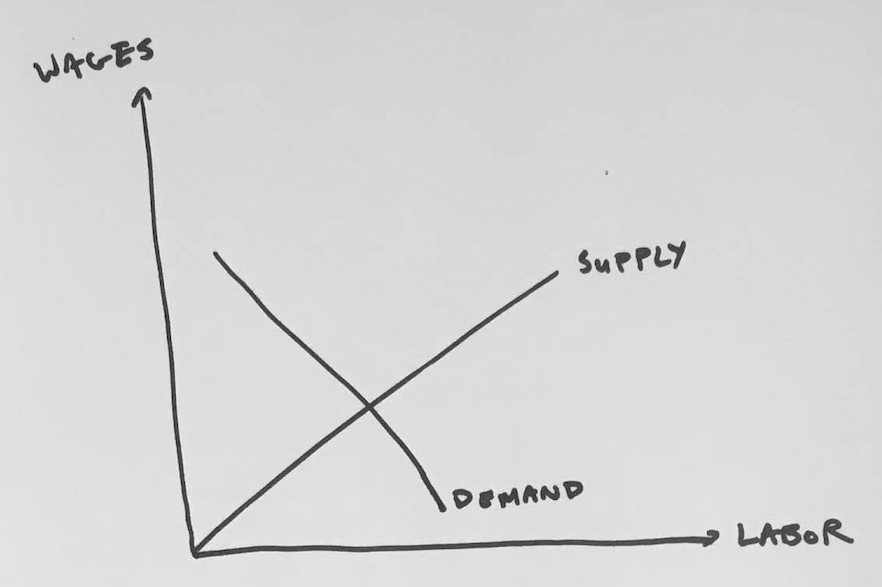
The shape of this curve is a function of the marginal utility of higher income to each worker, which looks like the following:
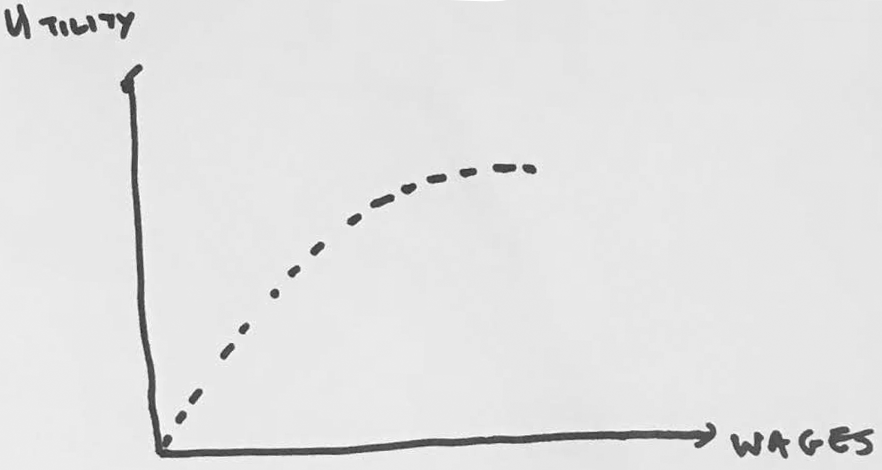
The assumption here is that each additional dollar of income is increasingly useful to a worker, because it enables the purchase of more basic goods, leisure goods, and consumption goods.
Just as there is a ceiling to the amount of income which can be spent on basic goods (food, shelter, etc), we posit that, given our above discussion, there are now natural ceilings on the amount of income which most workers will spend on leisure goods and conspicuous consumption goods.
First, the ceiling on income useful for purchasing leisure goods is the monthly cost of an ISP or cellular data plan (along with the cost of the hardware used to access the internet).
Second, the ceiling on income useful for conspicuous consumption is effectively zero – until you reach the ‘power threshold’ where you can spend enough to distinguish yourself as part of the top 20% of spenders, which is incredibly high. Every extra dollar of income you earn below this power threshold is effectively useless for the sake of conspicuous consumption, because on a relative basis it’s not enough to out-signal the ‘best.’
We propose, therefore, that the utility of marginal income actually looks like this:
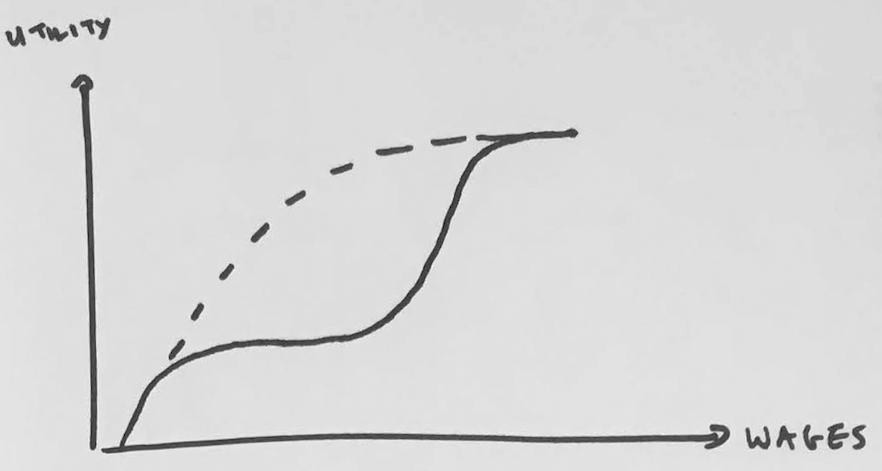
And, as a result, there is a ‘kinky labor supply curve:’

The classical labor supply curve would intersect the labor demand curve at (E0), and although the kinky labor supply curve intersects the labor demand curve at (E2), firms can decrease wages from here without decreasing productive output, all the way down to the actual equilibrium point at (E1). This suboptimal equilibrium entails that:
-
There is lower employment, which is a deadweight loss to the economy (lower overall economic output). There is actually greater demand for labor than can be met, but there’s no way to realize it because marginal increases in wages yield no increase in supply of labor past the equilibrium point (E1).
-
Wages are lower, which is an effective economic transfer from labor to firms. Firms would actually be willing to pay higher wages to the workers they employ, but because this would not yield more hours of labor, firms do not increase wages, so every hour of labor performed by a worker is paid at a lower wage rate than workers would earn at the classical equilibrium point.
A compounding factor worth noting here is the gig economy and the increase in availability of on-demand work, which helps workers realize a much more continuous distribution of preferences for allocating time across work and leisure (vs their ability to historically do so, which would have been more discrete / discontinuous). The gig economy makes labor supply more elastic at the lower, leftmost portion of the labor supply curve and removes what you might think of as a floor on labor supply that was imposed by the standard forty hour work week. (h/t Sam Lessin for calling our attention to the gig economy as another pressure on labor supply.)
The Kinky Labor Supply Curve Results in Lower Overall Economic Output
Because the demand for labor exceeds what workers are willing to supply, production and overall economic output are lower when workers prefer media entertainment leisure over wages.
You might argue this is a good thing. People actually prefer to spend their time consuming media over working, and we have achieved the luxury of enabling them to act on this preference. And, when people primarily consume digital media goods, the result is the production and consumption of less physical trash.
On the other hand, you might argue that lower economic output is a bad thing. Historically, economic growth has raised standards of living, increased lifespan, and has generally enabled more stable societies that are more insulated from the volatility of nature (eg, locusts eating an entire season of crops).
If you’re in the camp that thinks lower economic output is bad, the natural follow-up question is what kind of policy changes might counteract this phenomenon.
Policies for the Leisure State
If firms are unable to generate increases in labor supply by increasing wages, government transfers to workers would be be an equally ineffective solution when workers value leisure time over increased purchasing power. This entails that the possible solution space is probably limited to taxes (and probably does not include, for example, things like wage subsidies or an increased minimum wage).
One potential solution would be to tax the unproductive leisure activities which people prefer over work. This is perhaps not as crazy as it seems, because (i) the true cost of these activities is already distorted from a consumer perspective by the advertisers who subsidize media consumption,and (ii) we already tax income and productivity – if time and money are fungible, you might just pull the idea of income tax ‘above’ the decision of how to spend time, and say that each person is responsible for investing some amount of sweat (in the form of time or money) into the public good.
Of course it would be impossible to gain political support for such a radical idea, especially when people today enjoy leisure time for free. No one would support a policy that required them to buy this time back from the state in the form of a tax.
Since media companies are capitalizing and profiting on a huge amount of attention that might otherwise be spent productively, however, taxing them for the share of the citizenry’s time that they consume could be more sensible and more practical than taxing citizens themselves.
One view of the status quo is that media companies are aggregating human attention and selling it at a discount–far below minimum wage–to advertisers in a massive arbitrage on human capital. So, the state could set the price of an hour of human attention at the minimum wage rate, and charge media companies 12% (the federal income tax rate on minimum wage) of that wage rate for each hour of human attention they consume.
Media companies would respond in one of two ways, because they no doubt earn nowhere close to the amount of profit they would need to pay this tax. They could charge more to advertisers, ending the current price arbitrage on human attention. Or, they could pass the cost on to consumers directly, charging per unit of consumption instead of offering infinite consumption for a fixed price.
Why limit the attention tax to media companies vs all providers of leisure goods?
It seems a bit odd to single out consumption of digital media as a uniquely taxable leisure activity – why not tax all leisure activities?
What’s attractive about restricting the tax to digital media companies is that (i) they are profiting on the captured attention already and (ii) consumption of digital media is highly measurable. One of the challenges of the attention tax is measurement, and probably one of the reasons we have never considered such a tax viable in the past is the challenge of enforceability – it would be impossible for the state to measure the difference at a per citizen level of a productive unpaid hour (eg, care for a child or elderly person) from a leisure hour (spent reading a physical book).
While today it would still be difficult for the state to account for every hour of each citizen’s time, it would be quite feasible to measure each person’s hours of attention that were definitely spent consuming digital media entertainment. Taxing only these hours would be both practical and meaningful in terms of total percentage of time measured and enforceable in practice.
Takeaways
While it is fun to explore alternative mechanisms for motivating the labor force if labor supply no longer responds to increases in wages, it is far more likely that lost worker productivity will be made up for with technology (eg, automation via robotics, software, artificial intelligence) that makes remaining workers more productive. While this would lead to a host of other problems (eg, inequality) and almost certainly lead to a welfare state, it is probably more straightforward to implement the necessary technological advances than the attention tax. Furthermore, a welfare state where most people could devote most of their time to the pursuit of leisure seems to be more consistent with preferences revealed by recent trends in labor participation and alternative uses of time.
This essay was co-authored by Andrew Kortina and Namrata Patel.